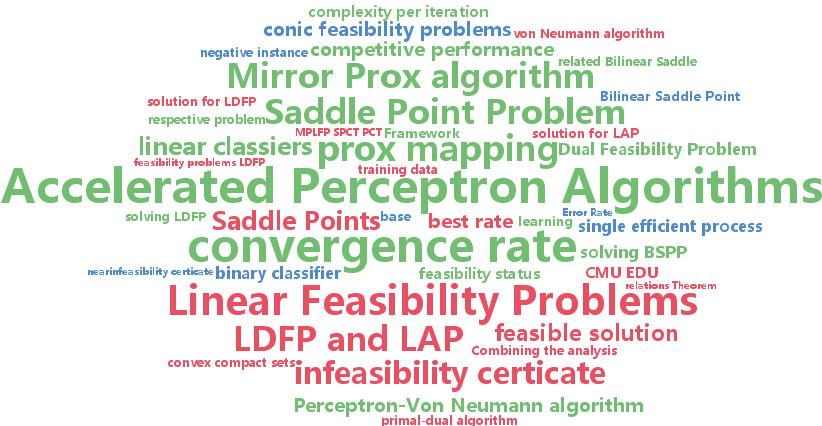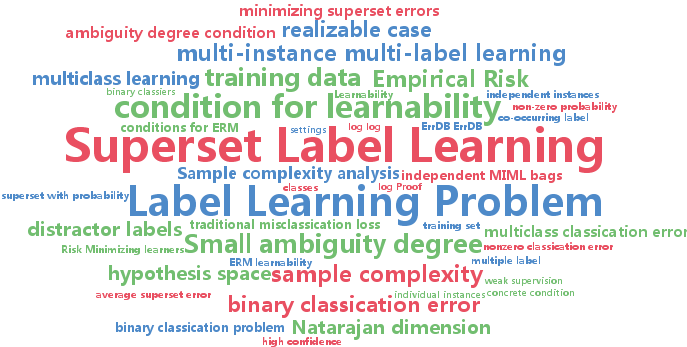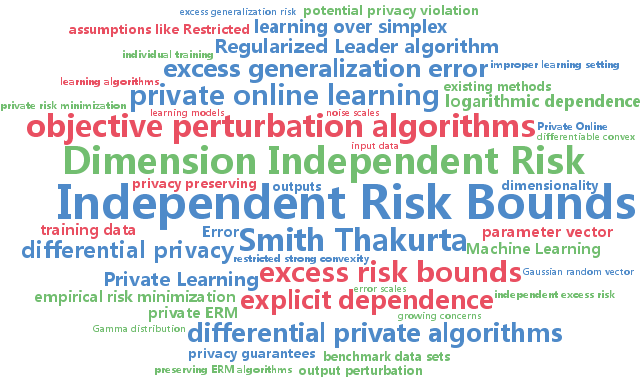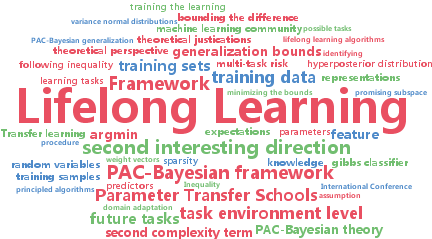training data
-
Adams Wei Yu and Fatma Kilinc-Karzan and Jaime Carbonell
Saddle Points and Accelerated Perceptron Algorithms (pdf)
In this paper, we consider the problem of finding a linear (binary) classifier or providing a near-infeasibility certificate if there is none. We bring a new perspective to addressing these two problems simultaneously in a single efficient process, by investigating a related Bilinear Saddle Point Problem (BSPP). More specifically, we show that a BSPP-based approach provides either a linear classifier or an $\epsilon$-infeasibility certificate. We show that the accelerated primal-dual algorithm, Mirror Prox, can be used for this purpose and achieves the best known convergence rate of $O({\sqrt{\log n
-
Matt Kusner and Stephen Tyree and Kilian Weinberger and Kunal Agrawal
Stochastic Neighbor Compression (pdf)
We present Stochastic Neighborhood Compression (SNC), an algorithm to compress a dataset for the purpose of k-nearest neighbor (kNN) classification. Given training data, SNC learns a much smaller synthetic data set, that minimizes the stochastic 1-nearest neighbor classification error on the training data. This approach has several appealing properties: due to its small size, the compressed set speeds up kNN testing drastically (up to several orders of magnitude, in our experiments); it makes the kNN classifier substantially more robust to label noise; on 4 of 7 data sets it yields lower test error than kNN on the entire training set, even at compression ratios as low as 2%; finally, the SNC compression leads to impressive speed ups over kNN even when kNN and SNC are both used with ball-tree data structures, hashing, and LMNN dimensionality reduction, demonstrating that it is complementary to existing state-of-the-art algorithms to speed up kNN classification and leads to substantial further improvements.
-
Trung Nguyen and Edwin Bonilla
Fast Allocation of Gaussian Process Experts (pdf)
We propose a scalable nonparametric Bayesian regression model based on a mixture of Gaussian process (GP) experts and the inducing points formalism underpinning sparse GP approximations. Each expert is augmented with a set of inducing points, and the allocation of data points to experts is defined probabilistically based on their proximity to the experts. This allocation mechanism enables a fast variational inference procedure for learning of the inducing inputs and hyperparameters of the experts. When using $K$ experts, our method can run $K^2$ times faster and use $K^2$ times less memory than popular sparse methods such as the FITC approximation. Furthermore, it is easy to parallelize and handles non-stationarity straightforwardly. Our experiments show that on medium-sized datasets (of around $10^4$ training points) it trains up to 5 times faster than FITC while achieving comparable accuracy. On a large dataset of $10^5$ training points, our method significantly outperforms six competitive baselines while requiring only a few hours of training.
-
Jeff Donahue and Yangqing Jia and Oriol Vinyals and Judy Hoffman and Ning Zhang and Eric Tzeng and Trevor Darrell
DeCAF: A Deep Convolutional Activation Feature for Generic Visual Recognition (pdf)
We evaluate whether features extracted from the activation of a deep convolutional network trained in a fully supervised fashion on a large, fixed set of object recognition tasks can be re-purposed to novel generic tasks. Our generic tasks may differ significantly from the originally trained tasks and there may be insufficient labeled or unlabeled data to conventionally train or adapt a deep architecture to the new tasks. We investigate and visualize the semantic clustering of deep convolutional features with respect to a variety of such tasks, including scene recognition, domain adaptation, and fine-grained recognition challenges. We compare the efficacy of relying on various network levels to define a fixed feature, and report novel results that significantly outperform the state-of-the-art on several important vision challenges. We are releasing DeCAF, an open-source implementation of these deep convolutional activation features, along with all associated network parameters to enable vision researchers to be able to conduct experimentation with deep representations across a range of visual concept learning paradigms.
-
Liping Liu and Thomas Dietterich
Learnability of the Superset Label Learning Problem (pdf)
In the Superset Label Learning (SLL) problem, weak supervision is provided in the form of a {\it superset
-
Prateek Jain and Abhradeep Guha Thakurta
(Near) Dimension Independent Risk Bounds for Differentially Private Learning (pdf)
In this paper, we study the problem of differentially private risk minimization where the goal is to provide differentially private algorithms that have small excess risk. In particular we address the following open problem: \emph{Is it possible to design computationally efficient differentially private risk minimizers with excess risk bounds that do not explicitly depend on dimensionality ($p$) and do not require structural assumptions like restricted strong convexity?
-
Anastasia Pentina and Christoph Lampert
A PAC-Bayesian bound for Lifelong Learning (pdf)
Transfer learning has received a lot of attention in the machine learning community over the last years, and several effective algorithms have been developed. However, relatively little is known about their theoretical properties, especially in the setting of lifelong learning, where the goal is to transfer information to tasks for which no data have been observed so far. In this work we study lifelong learning from a theoretical perspective. Our main result is a PAC-Bayesian generalization bound that offers a unified view on existing paradigms for transfer learning, such as the transfer of parameters or the transfer of low-dimensional representations. We also use the bound to derive two principled lifelong learning algorithms, and we show that these yield results comparable with existing methods.
-
Mohamad Ali Torkamani and Daniel Lowd
On Robustness and Regularization of Structural Support Vector Machines (pdf)
Previous analysis of binary SVMs has demonstrated a deep connection between robustness to perturbations over uncertainty sets and regularization of the weights. In this paper, we explore the problem of learning robust models for structured prediction problems. We first formulate the problem of learning robust structural SVMs when there are perturbations in the feature space. We consider two different classes of uncertainty sets for the perturbations: ellipsoidal uncertainty sets and polyhedral uncertainty sets. In both cases, we show that the robust optimization problem is equivalent to the non-robust formulation with an additional regularizer. For the ellipsoidal uncertainty set, the additional regularizer is based on the dual norm of the norm that constrains the ellipsoidal uncertainty. For the polyhedral uncertainty set, we show that the robust optimization problem is equivalent to adding a linear regularizer in a transformed weight space related to the linear constraints of the polyhedron. We also show that these constraint sets can be combined and demonstrate a number of interesting special cases. This represents the first theoretical analysis of robust optimization of structural support vector machines. Our experimental results show that our method outperforms the nonrobust structural SVMs on real world data when the test data distributions is drifted from the training data distribution.







